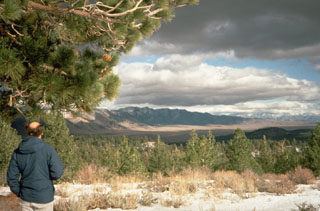Report on Long Valley (United States) — June 1983
Scientific Event Alert Network Bulletin, vol. 8, no. 6 (June 1983)
Managing Editor: Lindsay McClelland.
Long Valley (United States) Earthquake swarms but no deformation changes
Please cite this report as:
Global Volcanism Program, 1983. Report on Long Valley (United States) (McClelland, L., ed.). Scientific Event Alert Network Bulletin, 8:6. Smithsonian Institution. https://doi.org/10.5479/si.GVP.SEAN198306-323822
Long Valley
United States
37.7°N, 118.87°W; summit elev. 3390 m
All times are local (unless otherwise noted)
Occasional periods of increased seismicity have continued in the Long Valley area. On 4 June a series of 100-150 small (maximum M 2.1) events occurred in the S part of the caldera, about 1 km N of the January epicentral zone. Focal depths of the June earthquakes ranged from about 3.8-4.9 km. Several km S of the caldera rim, in the aftershock zone of the four M 5.5-6.1 earthquakes of 25-27 May 1980, a M 4 event occurred on 3 July at 0950, followed by a M 5 shock in the same area at 1140. About 150 aftershocks have been recorded at depths of 8-10 km, the largest a M 3.5.
Little measurable deformation has been detected during the past several months, but large areas of the caldera are inaccessible until summer because of heavy snow cover. Considerable uplift and horizontal extension had occurred between 1975 and mid-1982 in the W-central part of the caldera (SEAN 07:08), but data from summer field work will be necessary before geophysicists can determine if this activity has continued.
Geological Summary. The large 17 x 32 km Long Valley caldera east of the central Sierra Nevada Range formed as a result of the voluminous Bishop Tuff eruption about 760,000 years ago. Resurgent doming in the central part of the caldera occurred shortly afterwards, followed by rhyolitic eruptions from the caldera moat and the eruption of rhyodacite from outer ring fracture vents, ending about 50,000 years ago. During early resurgent doming the caldera was filled with a large lake that left strandlines on the caldera walls and the resurgent dome island; the lake eventually drained through the Owens River Gorge. The caldera remains thermally active, with many hot springs and fumaroles, and has had significant deformation, seismicity, and other unrest in recent years. The late-Pleistocene to Holocene Inyo Craters cut the NW topographic rim of the caldera, and along with Mammoth Mountain on the SW topographic rim, are west of the structural caldera and are chemically and tectonically distinct from the Long Valley magmatic system.
Information Contacts: R. Cockerham, D. Hill, USGS, Menlo Park, CA; D. Dzurisin, USGS CVO, Vancouver, WA.

